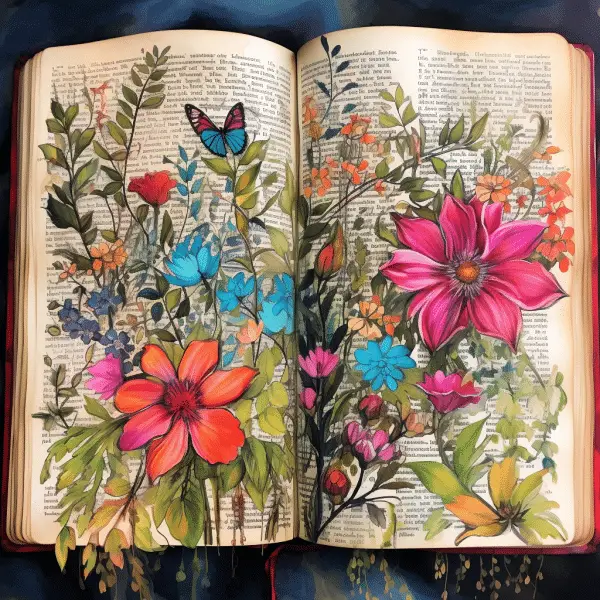

Bible study and Bible journaling is done in a group or alone, using study guides or commentaries. Bible journaling encourages a more artistic and introspective approach, allowing individuals to connect with God’s word in a visually expressive way.
The concept of Bible study has been an integral part of Christian tradition for centuries. Ancient theologians studied scripture rigorously. Bible journaling is a modern concept that emerged in response to the need for creative engagement with scripture. It’s become popular and it’s growing due to its presence on social media.
Definition of Bible Study
To gain a clear understanding of Bible study, dive into the definition with a focus on what it involves and the importance it holds. The explanation of what Bible study involves will shed light on the methods and practices used, while exploring the importance will highlight the value it brings to one’s spiritual journey.
During the Middle Ages, illuminated manuscripts were created by scribes who carefully transcribed the Bible by hand while decorating it with intricate illustrations and decorations. This practice acted as a kind of meditation and devotion as believers spent hours reflecting on both the words on the page and the visual representations accompanying them.
Explanation of What Bible Study Involves
Bible study is a way to engage with scripture and understand its teachings. It means reading, analyzing, and interpreting the Bible. By studying the context, language, and history, people can get insight into the intended meaning.
Prayerful contemplation and reflection on the passages helps people connect with God and seek guidance. It allows for personal application of the scriptures to one’s own life. Plus, discussing and sharing insights with others can lead to different perspectives.
To get the most out of Bible study, it is important to have an open mind and a sincere desire to learn. Setting time aside for study, free from distractions, helps focus. Additionally, using study aids like commentaries or concordances can provide context.
Bible study is not just about knowledge. It’s about deepening one’s relationship with God. It’s a spiritual discipline that allows people to encounter God’s truth and apply it. Approaching Bible study with reverence and humility leads to transformative insights and a closer walk with God.
Importance of Bible Study
Bible study has great importance in many individuals’ lives. Exploring the scriptures brings a better understanding of faith and a stronger bond with God. This practice helps believers to grow spiritually and get direction for facing life’s difficulties.
Engaging in Bible study can give deep understanding and revelations about the stories and teachings within its pages. It’s a chance to think about one’s own life and act in agreement with biblical principles. Doing this can bring wisdom, judgement, and moral clarity to help with decision-making.
Also, Bible study encourages community and friendship among believers. It’s an opportunity to debate scripture, tell personal stories, and learn from each other. This communal part enriches the learning experience and motivates people to live out the values and lessons gained.
It’s interesting to note that Bible study has been done for centuries in different cultures. Its relevance is seen through the numerous commentaries, interpretations, and scholarly works created by theologians throughout history. Examining the Bible still invigorates minds and nourishes souls as seekers discover its perpetual truths.
Definition of Bible Journaling
To gain a deeper understanding of Bible journaling and its significance, explore the definition of this practice. This section will delve into what Bible journaling involves and the benefits it offers. Explanation of what Bible journaling involves and the benefits derived from engaging in this creative spiritual practice will be discussed.
Explanation of What Bible Journaling Involves
Bible journaling is an inventive way to engage with the Scriptures. It fuses visual elements like drawings, paintings, and hand lettering with written reflections and prayers. This lets individuals deepen their understanding of the text, make connections between passages, and express their faith uniquely.
Artistic expression is combined with studying the Bible, giving people a tangible way to interact with God’s Word while using their creativity. This often leads to a deeper sense of connection and better comprehension. Through this method, bible journalers can explore scripture in a personal and interactive manner.
Bible journaling encourages individuals to slow down and consider the verses they are illustrating. As they choose images or create artwork that conveys the essence of a passage, they contemplate its meaning more deeply. This intentional reflection helps internalize biblical truths and apply them to life.
Studies have proven art therapy can improve mental health by reducing stress levels and promoting relaxation. Bible journaling has these therapeutic elements, offering an outlet for self-expression and mindfulness within a religious context.
Benefits of Bible Journaling
Bible journaling has many advantages which enhance the spiritual voyage. First, it helps people to connect more deeply with the text, and thus God. Secondly, it helps one to explore themselves and contemplate, through expressing their feelings and thoughts creatively. Plus, it creates a friendly network of people who share their ideas and masterpieces online.
It also functions as a type of meditation, bringing relief and peace in this fast-paced world. It’s a visible reminder of God’s presence and teachings in daily life. Moreover, visually representing Scripture helps to better remember and comprehend its messages.
What makes Bible journaling unique is the individualistic side it has. Everyone’s interpretation of Scripture is different, making it highly personal and suitable for one’s beliefs and life.
Research by The Journal For Creative Arts Therapy (2019) shows that engaging in Bible journaling can decrease stress levels and improve mental health.
Differences between Bible Study and Bible Journaling
To better understand the differences between Bible study and Bible journaling, consider the purpose and focus, method and approach, level of interaction with the text, and the benefits and outcomes. Each sub-section will shed light on these distinctions, helping you navigate these unique practices effectively.
Purpose and Focus
Examining and reflecting on the Bible is crucial. However, there is a difference between Bible Study and Bible Journaling. To understand the distinctions, let’s compare their purpose and focus in this table:
| Purpose | Focus |
|---|---|
| Bible Study | Analyzing biblical text, researching historical context, and understanding theological concepts. |
| Bible Journaling | Combining visual artistry with personal reflections, emotions, and prayers inspired by Scripture. |
Bible Journaling stands apart from traditional Bible Study. It integrates creativity and personal reflection into the experience. Here are some suggestions for each approach:
For Bible Study:
- Dedicate time to reading and research.
- Use study tools like concordances or commentaries.
- Join group discussions or take theological classes.
For Bible Journaling:
- Select a journal or sketchbook just for this practice.
- Include colors, drawings, or symbols that match verses.
- Allow time for personal reflection while creating art.
These suggestions help reach the intended purpose and focus of each practice. Bible Study encourages intellectual growth, and Bible Journaling strengthens emotional connection to Scripture. By recognizing the differences, individuals can pick a path that is suited to their preferences, deepening their spiritual journey.
Method and Approach
Bible Study and Bible Journaling are two amazing methods for spiritual growth. Bible Study focuses on reading, analyzing, and dissecting scripture passages with critical thinking and reasoning. It helps to gain understanding of the message. Bible Journaling is about expressing emotions and personal experiences through visual representation. It encourages self-expression and connection with God’s word.
Both methods have their own benefits. Bible Study enhances knowledge of biblical teachings and promotes spiritual growth. Bible Journaling strengthens bond with God and increases mindfulness during reading.
A unique aspect of Bible Journaling is the focus on personalization. Through art, drawings, and color, people can highlight memorable verses or create visual representations of their emotional responses.
Tip: To get the most out of either method, combine traditional study techniques such as cross-referencing with creative annotations in your journal. During the Middle Ages, illuminated manuscripts were created by scribes who carefully transcribed the Bible by hand while decorating it with intricate illustrations and decorations. This practice acted as a kind of meditation and devotion as believers spent hours reflecting on both the words on the page and the visual representations accompanying them. This will help you gain a well-rounded understanding and stay connected to your own emotions and interpretations.
Level of Interaction with the Text
For Bible study, participants look deeper into scripture. With tools like concordances, commentaries, or language references. They consider the historical context and many interpretations. Plus, they talk with others about it.
Bible journaling is more artistic and expressive. People create visual representations in their Bibles. With watercolors, colored pencils, or collage. Drawings, hand-lettered verses, or meaningful symbols show their personal connection.
Both approaches have benefits. Bible study is for intellectual growth. And Bible journaling is for a deeper emotional level. It’s a way to express and create while meditating.
To make Bible study better:
- Engage in discussions.
- Use study resources.
- Research the background.
- Consider diverse interpretations.
To make Bible journaling better:
- Reflect on personal connections.
- Experiment with art mediums.
- Look for inspiration.
- Incorporate symbols.
These suggestions help deepen the interaction with the text. Both approaches offer growth in faith and understanding.
Benefits and Outcomes
Bible Study and Bible Journaling provide people with the chance to deeply engage in scripture. While both have their own unique benefits, there are some differences. Let’s examine:
Benefits and Outcomes
| Bible Study | Bible Journaling | |
|---|---|---|
| Process | Systematic examination of scriptures | Creative exploration through writing and art |
| Focus | Acquiring knowledge of biblical teachings | Personal reflection and application |
| Engagement | Intellectual analysis | Emotional connection |
| Approach | Structured | Flexible |
| Outcome | Deeper understanding | Spiritual growth |
Bible Journaling also offers the chance to personalize their spiritual journey. For example, by adding colors, illustrations, and decorative elements.
To get the most out of Bible Study/Journaling, here are some tips:
- Set Goals.
- Stick to a routine.
- Join a study group.
- Be inventive.
By following these guidelines, individuals can gain a better understanding of scriptures, leading to spiritual growth. During the Middle Ages, illuminated manuscripts were created by scribes who carefully transcribed the Bible by hand while decorating it with intricate illustrations and decorations. This practice acted as a kind of meditation and devotion as believers spent hours reflecting on both the words on the page and the visual representations accompanying them.
Similarities between Bible Study and Bible Journaling
To explore the similarities between Bible study and Bible journaling, focus on their shared goal of spiritual growth, use of Scripture as a guide, and personal reflection and application. These sub-sections will shed light on the ways both practices contribute to deepening your understanding of the Bible and nurturing your spiritual journey.
Shared Goal of Spiritual Growth
A shared purpose of spiritual advancement is a common goal that Bible study and Bible journaling both pursue. These practices try to enhance one’s comprehension of the Bible and improve their connection with God.
- Bible study needs careful scrutiny of scripture via reading, contemplation, and examination. It strives to uncover the profound truths in the text and apply them to life.
- In contrast, Bible journaling fuses creative expression with scripture interpretation. It encourages people to actively engage with the Word of God by illustrating verses, taking notes, or even making attractive pages in a journal or notebook.
- Both of these methods stress the importance of devoting time to God’s Word for personal growth and sustenance.
- They urge people to explore scripture more deeply, searching for wisdom, direction, and revelation.
- Also, they promote a real connection with God as individuals open their hearts and minds to His teachings.
Middle Ages
In addition, these practices have distinctive aspects that set them apart. Bible study allows for in-depth investigation of various biblical themes or interests, while Bible journaling provides a route for self-expression through art. During the Middle Ages, illuminated manuscripts were created by scribes who carefully transcribed the Bible by hand while decorating it with intricate illustrations and decorations. This practice acted as a kind of meditation and devotion as believers spent hours reflecting on both the words on the page and the visual representations accompanying them.
A deep history concerning this shared goal can be tracked back throughout history. Believers sought ways to delve into scripture more intimately. During the Middle Ages, illuminated manuscripts were created by scribes who carefully transcribed the Bible by hand while decorating it with intricate illustrations and decorations. This practice acted as a kind of meditation and devotion as believers spent hours reflecting on both the words on the page and the visual representations accompanying them.
Use of Scripture as a Guide
The use of Scripture as a guide is key to both Bible Study and Bible Journaling. It offers direction and wisdom for spiritual growth and understanding. The Bible serves as a compass, leading believers to God’s truth and His heart. Bible Study and Bible Journaling both dissect, examine, and meditate upon Scriptures. Through these methods, we apply and gain insight into them.
Bible Study focuses on specific chapters and topics. This enables us to understand the intended message and allows for thoughtful interpretation. Bible Journaling also utilizes Scripture as a guide. But it combines artistic expression and personal reflection on biblical passages. People highlight verses or phrases that resonate with them. Then they creatively respond, incorporating colors, images, or calligraphy in their journal entries. This process helps illustrate their understanding and emotions.
Both Bible Study and Bible Journaling share a common goal: to deepen our relationship with God through His Word.
The power of using Scripture as a guide can be seen in Maria’s story. Maria had been struggling with anxiety for years. When feeling overwhelmed, she remembered a verse she had read – “Do not be anxious about anything” (Philippians 4:6). She used Bible Study techniques to explore the context and meditate on the meaning. This brought her peace. So, she journaled her reflections in vivid colors, expressing her newfound sense of serenity.
Scripture provided Maria with divine wisdom and stimulated creativity and self-expression. It had helped her find solace and practical strategies to combat her anxiety.
Personal Reflection and Application
Personal reflection and application are fundamental for Bible study and Bible journaling. Both activities help people to understand the Bible and link it to their lives. During the Middle Ages, illuminated manuscripts were created by scribes who carefully transcribed the Bible by hand while decorating it with intricate illustrations and decorations. This practice acted as a kind of meditation and devotion as believers spent hours reflecting on both the words on the page and the visual representations accompanying them.
Bible study needs thorough study and analysis of the scriptures, including reading, research into the background, and conversations about interpretations. In Bible journaling, someone contemplates particular verses or passages by making art or writing down their ideas in a journal. This allows for contemplation and using Bible principles in everyday life.
In Bible study, a special part is group discussion. By talking to others, one can gain different points of view and wisdom about the text. In contrast, Bible journaling offers a personal and visual route to reflection. Making art or writing can be a form of meditation and self-expression.
King David’s story is an example of how powerful personal reflection and application can be. Despite his mistakes, David kept praying and reflecting on his behaviour. His reflections enabled him to identify his weaknesses, ask for forgiveness and make changes in his life. This tale reveals the incredible effect of personal reflection on someone’s spiritual journey.
Conclusion
When it comes to Bible study and Bible journaling, there are key differences. Bible study is an analytical approach to scripture. It involves reading, interpreting, and discussing the text. The aim is to deepen understanding.
Bible journaling is creative. It combines artistic expression with reflection on scripture. It often involves illustrating verses in a notebook or journal. This allows a person to engage with the Word in a visual way. Study primarily centers on deepening knowledge and understanding of the scriptures through analysis, whereas Bible journaling emphasizes personal expression and engagement with the text through creative means.
Bible study and Bible journaling both have merits. Bible study encourages deep engagement with the text. It fosters insight into meaning and application. On the other hand, Bible journaling enables individuals to create personal connections with scripture. It’s a process of creation and reflection.
Frequently Asked Questions
Q: What is Bible study?
A: Bible study refers to the practice of exploring and examining the teachings, texts, and messages within the Bible. It involves deepening understanding, interpretation, and analysis of the scriptures through various methods like reading, research, discussion, and reflection.
Q: What is Bible journaling?
A: Bible journaling is a creative and personal way of engaging with the Bible. It involves combining artistic expression, such as drawing, painting, or writing, with the study of biblical passages. It allows individuals to visually capture their thoughts, reflections, prayers, and insights in the margins or on separate pages within a journaling Bible.
Q: How is Bible study different from Bible journaling?
A: The main difference between Bible study and Bible journaling lies in the approach and focus. Bible study primarily centers on deepening knowledge and understanding of the scriptures through analysis, whereas journaling emphasizes personal expression and engagement with the text through creative means.
Q: Can Bible study and Bible journaling be done together?
A: Absolutely! Bible study and Bible journaling can complement each other and be done in tandem. Many individuals find that combining the two practices enhances their understanding and connection with the scriptures. One can study the Bible using traditional methods and then incorporate journaling to visually capture insights and reflections.
Q: Do I need artistic skills to practice Bible journaling?
A: No, artistic skills are not necessary to practice Bible journaling. It is a personal and creative expression, and there are no rules or expectations regarding artistic ability. The focus is on engaging with the biblical text in a meaningful way, and anyone can participate using simple techniques like coloring, lettering, or writing.
Q: Which approach is best for me – Bible study or Bible journaling?
A: The choice between Bible study and Bible journaling depends on your personal preferences, learning style, and desired connection with the scriptures. If you enjoy research, analysis, and a deeper understanding, Bible study might be ideal. If you prefer a more creative and visual approach that allows for personal expression, Bible journaling might be the right fit. Ultimately, you can also explore a combination of both practices to maximize your spiritual growth.








